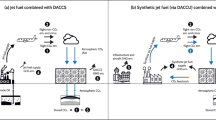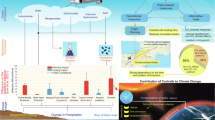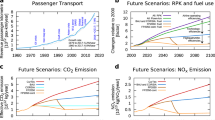Abstract
To meet ambitious climate targets, the aviation sector needs to neutralize CO2 emissions and reduce non-CO2 climatic effects. Despite being responsible for approximately two-thirds of aviation’s impacts on the climate, most of aviation non-CO2 species are currently excluded from climate mitigation efforts. Here we identify three plausible definitions of climate-neutral aviation that include non-CO2 forcing and assess their implications considering future demand uncertainty, technological innovation and CO2 removal. We demonstrate that simply neutralizing aviation’s CO2 emissions, if nothing is done to reduce non-CO2 forcing, causes up to 0.4 °C additional warming, thus compromising the 1.5 °C target. We further show that substantial rates of CO2 removal are needed to achieve climate-neutral aviation in scenarios with little mitigation, yet cleaner-flying technologies can drastically reduce them. Our work provides policymakers with consistent definitions of climate-neutral aviation and highlights the beneficial side effects of moving to aircraft types and fuels with lower indirect climate effects.
This is a preview of subscription content, access via your institution
Access options
Access Nature and 54 other Nature Portfolio journals
Get Nature+, our best-value online-access subscription
$32.99 / 30 days
cancel any time
Subscribe to this journal
Receive 12 print issues and online access
$259.00 per year
only $21.58 per issue
Buy this article
- Purchase on SpringerLink
- Instant access to full article PDF
Prices may be subject to local taxes which are calculated during checkout






Similar content being viewed by others
Data availability
The input data to this analysis is publicly available at https://esgf-node.llnl.gov/search/input4mips/. The data output in this study, that is, the raw data of figures, can be accessed under the folder ‘Outputs’: https://github.com/nikibraz/definitions_climateneutral_aviation.git.
Code availability
The code used to generate figures and tables is available at https://github.com/nikibraz/definitions_climateneutral_aviation.git and will be made publicly available upon acceptance.
References
Gössling, S. & Humpe, A. The global scale, distribution and growth of aviation: implications for climate change. Glob. Environ. Change 65, 102194 (2020).
Global Market Forecast 2018–2037, Global Networks, Global Citizens (Airbus, 2018).
Commercial Market Outlook 2021–2040 (Boeing, 2021).
Forster, P. M., de, F., Shine, K. P. & Stuber, N. It is premature to include non-CO2 effects of aviation in emission trading schemes. Atmos. Environ. 40, 1117–1121 (2006).
Dahlmann, K., Grewe, V., Frömming, C. & Burkhardt, U. Can we reliably assess climate mitigation options for air traffic scenarios despite large uncertainties in atmospheric processes? Transp. Res. D 46, 40–55 (2016).
Lee, D. S. The Current State of Scientific Understanding of the Non-CO2 Effects of Aviation on Climate (Department for Transport, 2018).
Larsson, J., Elofsson, A., Sterner, T. & Åkerman, J. International and national climate policies for aviation: a review. Clim. Policy 19, 787–799 (2019).
Soria Baledón, M. & Kosoy, N. ‘Problematizing’ carbon emissions from international aviation and the role of alternative jet fuels in meeting ICAO’s mid-century aspirational goals. J. Air Transp. Manag. 71, 130–137 (2018).
Carbon Offsetting and Reduction Scheme for International Aviation (CORSIA) (ICAO, 2021).
Dubois, G. et al. It starts at home? Climate policies targeting household consumption and behavioral decisions are key to low-carbon futures. Energy Res. Soc. Sci. 52, 144–158 (2019).
Grewe, V. et al. Evaluating the climate impact of aviation emission scenarios towards the Paris Agreement including COVID-19 effects. Nat. Commun. 12, 3841 (2021).
Terrenoire, E., Hauglustaine, D., Gasser, T. & Penanhoat, O. The contribution of carbon dioxide emissions from the aviation sector to future climate change. Environ. Res. Lett. 14, 084019 (2019).
Sharmina, M. et al. Decarbonising the critical sectors of aviation, shipping, road freight and industry to limit warming to 1.5–2 °C. Clim. Policy 21, 455–474 (2021).
Lee, D. S. et al. The contribution of global aviation to anthropogenic climate forcing for 2000 to 2018. Atmos. Environ. 244, 117834 (2021).
Lee, D. S. et al. Aviation and global climate change in the 21st century. Atmos. Environ. 43, 3520–3537 (2009).
Klöwer, M. et al. Quantifying aviation’s contribution to global warming. Environ. Res. Lett. 16, 104027 (2021).
Burkhardt, U., Bock, L. & Bier, A. Mitigating the contrail cirrus climate impact by reducing aircraft soot number emissions. npj Clim. Atmos. Sci. 1, 37 (2018).
Kärcher, B. Formation and radiative forcing of contrail cirrus. Nat. Commun. 9, 1824 (2018).
Rogelj, J., Geden, O., Cowie, A. & Reisinger, A. Net-zero emissions targets are vague: three ways to fix. Nature 591, 365–368 (2021).
Archer, D. & Brovkin, V. The millennial atmospheric lifetime of anthropogenic CO2. Climatic Change 90, 283–297 (2008).
Eby, M. et al. Lifetime of anthropogenic climate change: millennial time scales of potential CO2 and surface temperature perturbations. J. Clim. 22, 2501–2511 (2009).
Knutti, R. & Rogelj, J. The legacy of our CO2 emissions: a clash of scientific facts, politics and ethics. Climatic Change 133, 361–373 (2015).
Smith, S. M. et al. Equivalence of greenhouse-gas emissions for peak temperature limits. Nat. Clim. Change 2, 535–538 (2012).
Fankhauser, S. et al. The meaning of net zero and how to get it right. Nat. Clim. Change https://doi.org/10.1038/s41558-021-01245-w (2021).
Brazzola, N., Wohland, J. & Patt, A. Offsetting unabated agricultural emissions with CO2 removal to achieve ambitious climate targets. PLoS ONE 16, e0247887 (2021).
Huntingford, C. et al. The implications of carbon dioxide and methane exchange for the heavy mitigation RCP2.6 scenario under two metrics. Environ. Sci. Policy 51, 77–87 (2015).
Allen, M. R. et al. New use of global warming potentials to compare cumulative and short-lived climate pollutants. Nat. Clim. Change 6, 773–776 (2016).
Allen, M. R. et al. A solution to the misrepresentations of CO2-equivalent emissions of short-lived climate pollutants under ambitious mitigation. npjj Clim. Atmos. Sci. 1, 28 (2018).
Cain, M. et al. Improved calculation of warming-equivalent emissions for short-lived climate pollutants. npj Clim. Atmos. Sci. 2, 29 (2019).
Smith, C. J. et al. FAIR v1.3: a simple emissions-based impulse response and carbon cycle model. Geosci. Model Dev. 11, 2273–2297 (2018).
Millar, R. J., Nicholls, Z. R., Friedlingstein, P. & Allen, M. R. A modified impulse-response representation of the global near-surface air temperature and atmospheric concentration response to carbon dioxide emissions. Atmos. Chem. Phys. 17, 7213–7228 (2017).
Meeting the UK Aviation Target—Options for Reducing Emissions to 2050 (Climate Change Commitee, 2009).
Allen, M. R. et al. Indicate separate contributions of long-lived and short-lived greenhouse gases in emission targets. npj Clim. Atmos. Sci. 5, 5 (2022).
Peeters, P., Higham, J., Kutzner, D., Cohen, S. & Gössling, S. Are technology myths stalling aviation climate policy? Transp. Res. D 44, 30–42 (2016).
Schäfer, A. W. et al. Technological, economic and environmental prospects of all-electric aircraft. Nat. Energy 4, 160–166 (2019).
Gnadt, A. R., Speth, R. L., Sabnis, J. S. & Barrett, S. R. H. Technical and environmental assessment of all-electric 180-passenger commercial aircraft. Prog. Aerosp. Sci. 105, 1–30 (2019).
Smith, P. et al. Biophysical and economic limits to negative CO2 emissions. Nat. Clim. Change 6, 42–50 (2016).
Ivanovich, C. C., Ocko, I. B., Piris-Cabezas, P. & Petsonk, A. Climate benefits of proposed carbon dioxide mitigation strategies for international shipping and aviation. Atmos. Chem. Phys. 19, 14949–14965 (2019).
Fuss, S. et al. Negative emissions—part 2: costs, potentials and side effects. Environ. Res. Lett. 13, 063002 (2018).
Niklaß, M. et al. Integration of Non-CO2 Effects of Aviation in the EU ETS and Under CORSIA (Umweltbundesamt, 2020).
Ishimoto, Y. et al. Putting Costs of Direct Air Capture in Context (Forum for Climate Engineering Assessment Working Paper Series, 2017); https://doi.org/10.2139/ssrn.2982422
IPCC. Climate Change 2021: The Physical Science Basis Contribution of Working Group I to the Sixth Assessment Report of the Intergovernmental Panel on Climate Change (Cambridge Univ. Press, 2021).
Meinshausen, M. et al. The shared socio-economic pathway (SSP) greenhouse gas concentrations and their extensions to 2500. Geosci. Model Dev. 13, 3571–3605 (2020).
Sustainable Aviation Fuels Roadmap—Fueling the Future of UK Aviation (Sustainable Aviation, 2020).
Clean Skies for Tomorrow: Sustainable Aviation Fuels as a Pathway to Net-Zero Aviation (World Economic Forum, 2021).
Bullerdiek, N., Neuling, U. & Kaltschmitt, M. A GHG reduction obligation for sustainable aviation fuels (SAF) in the EU and in Germany. J. Air Transp. Manag. 92, 102020 (2021).
Santos, K. & Delina, L. Soaring sustainably: promoting the uptake of sustainable aviation fuels during and post-pandemic. Energy Res. Soc. Sci. 77, 102074 (2021).
Becattini, V., Gabrielli, P. & Mazzotti, M. Role of carbon capture, storage, and utilization to enable a net-zero-CO2-emissions aviation sector. Ind. Eng. Chem. Res. 60, 6848–6862 (2021).
Braun-Unkhoff, M., Riedel, U. & Wahl, C. About the emissions of alternative jet fuels. CEAS Aeronaut. J. 8, 167–180 (2017).
Voigt, C. et al. Cleaner burning aviation fuels can reduce contrail cloudiness. Commun. Earth Environ. 2, 114 (2021).
Jagtap, S. S. Evaluation of blended Fischer–Tropsch jet fuel feedstocks for minimizing human and environmental health impacts of aviation. In AIAA Propulsion and Energy 2019 Forum, 4412 (AIAA, Indianapolis, 2019).
Blakey, S., Rye, L. & Wilson, C. W. Aviation gas turbine alternative fuels: a review. Proc. Combust. Inst. 33, 2863–2885 (2011).
Kadyk, T., Schenkendorf, R., Hawner, S., Yildiz, B. & Römer, U. Design of fuel cell systems for aviation: representative mission profiles and sensitivity analyses. Front. Energy Res. 7, 35 (2019).
Noland, J. K. Hydrogen electric airplanes: a disruptive technological path to clean up the aviation sector. IEEE Electrif. Mag. 9, 92–102 (2021).
Morrell, P. & Dray, L. Environmental Aspects of Fleet Turnover, Retirement and Life Cycle (Cranfield University and University of Cambridge, 2009).
Jenkins, S., Millar, R. J., Leach, N. & Allen, M. R. Framing climate goals in terms of cumulative CO2-forcing-equivalent emissions. Geophys. Res. Lett. 45, 2795–2804 (2018).
Rogelj, J. & Schleussner, C.-F. Unintentional unfairness when applying new greenhouse gas emissions metrics at country level. Environ. Res. Lett. 14, 114039 (2019).
Schleussner, C.-F., Nauels, A., Schaeffer, M., Hare, W. & Rogelj, J. Inconsistencies when applying novel metrics for emissions accounting to the Paris Agreement. Environ. Res. Lett. 14, 124055 (2019).
Lynch, J., Cain, M., Pierrehumbert, R. & Allen, M. Demonstrating GWP*: a means of reporting warming-equivalent emissions that captures the contrasting impacts of short- and long-lived climate pollutants. Environ. Res. Lett. 15, 044023 (2020).
Acknowledgements
N.B. is funded through a Doc.CH grant and acknowledges support from the Swiss National Academy of Science. J.W. was funded throughout the duration of this research through an ETH postdoctoral fellowship and thanks the ETH foundation and the Uniscientia Foundation for his funding.
Author information
Authors and Affiliations
Contributions
N.B., A.P. and J.W. designed the study. N.B. performed the analysis with support from J.W. N.B. and J.W. wrote the manuscript. All authors edited the manuscript and engaged in ongoing discussions.
Corresponding author
Ethics declarations
Competing interests
The authors declare no competing interests.
Peer review
Peer review information
Nature Climate Change thanks Lynnette Dray and the other, anonymous, reviewer(s) for their contribution to the peer review of this work.
Additional information
Publisher’s note Springer Nature remains neutral with regard to jurisdictional claims in published maps and institutional affiliations.
Supplementary information
Supplementary Information
Supplementary Methods (containing Supplementary Figs. 1–5 and Tables 1–4), References and Fig. 6.
Rights and permissions
About this article
Cite this article
Brazzola, N., Patt, A. & Wohland, J. Definitions and implications of climate-neutral aviation. Nat. Clim. Chang. 12, 761–767 (2022). https://doi.org/10.1038/s41558-022-01404-7
Received:
Accepted:
Published:
Issue date:
DOI: https://doi.org/10.1038/s41558-022-01404-7
This article is cited by
-
Climate-optimized flight planning can effectively reduce the environmental footprint of aviation in Europe at low operational costs
Communications Earth & Environment (2025)
-
The role of direct air capture in achieving climate-neutral aviation
Nature Communications (2025)
-
Catalytic production of aviation jet biofuels from biomass: a review
Environmental Chemistry Letters (2025)
-
The ozone radiative forcing of nitrogen oxide emissions from aviation can be estimated using a probabilistic approach
Communications Earth & Environment (2024)
-
Lightweight climate models could be useful for assessing aviation mitigation strategies and moving beyond the CO2-equivalence metrics debate
Communications Earth & Environment (2024)



